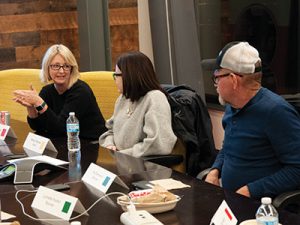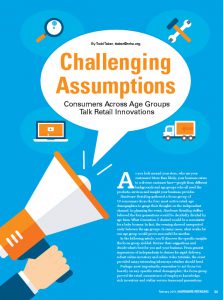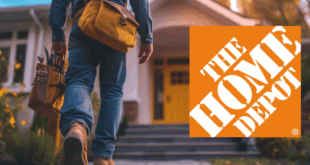Click the picture to download a PDF of this story.
By Todd Taber, ttaber@nrha.org
Challenging Assumptions
As you look around your store, who are your customers? More than likely, your business caters to a diverse customer base—people from different backgrounds and age groups who all need the products, services and insight your business provides.
Hardware Retailing gathered a focus group of 10 consumers from the four most active retail age demographics to gauge their thoughts on the independent channel. In planning the event, Hardware Retailing staffers believed the four generations would be decidedly divided by age lines: What Generation Z desired would be a non-starter for a baby boomer. In fact, the evening showed unexpected unity between the age groups. In many cases, what works for one age group would prove successful for another.
In the following article, you’ll discover the specific insights the focus group yielded. Review their suggestions and decide what’s best for you and your business. From general impressions of independents to desires for rapid delivery, robust online inventory and online video tutorials, the event provided many interesting takeaways retailers should heed.
Perhaps most importantly, remember to not focus too heavily on any specific retail demographic; the focus group proved the retail cornerstones of employee knowledge, rich inventory and stellar service transcend generations.
Meet the Generations
The focus group included representatives from the four most active age groups in retail, according to the Pew Research Center. Among them were new homeowners, DIYers and independent service providers, including masons and arborists.
Baby boomers are the oldest active retail group. Its members were born between 1946 and 1964.
Generation X have been active consumers for some time. Its members were born between 1965 and 1980.
Millennials are increasingly prominent in retail. Its members were born between 1981 and 1996.
Generation Z is the youngest retail cohort. Its members were born between 1997 and 2015.
- Hal Dickenson – Boomer
- Lynnette Husted – Boomer
- Dan Vernon – Generation X
- Heather Kauffman-Peters – Generation X
- Eric Burns – Millennial
- Nels Olson – Millennial
- Mike Long – Millennial
- David Dickenson – Millennial
- Amy Baldwin – Millennial
- Melissa Tratensek – Generation Z
General Home Improvement Views
Members of the consumer focus group began by discussing their general impressions of independent home improvement stores.
Nels Olson, a millennial homeowner, says convenience and familiarity are big motivators for where he chooses to shop.
“Independent businesses make you feel appreciated. I see the same people working there, and they recognize me. I feel like they actually have an interest in the projects I’m doing, and I don’t get that at the big boxes I visit,” he says.
Melissa Tratensek, the group’s sole Generation Z participant, says she doesn’t have much experience with home repair projects, but when she has visited independent operations, she feels welcomed.
“Every time I go to an independent, I find someone who actually listens and can help me, versus visiting a big box and leaving without even talking to someone,” she says.
Heather Kauffman-Peters, a Generation X participant, says she often finds special items when she shops at independent businesses.
“You can find unique items when you shop independents,” she says. “I’ve seen a lot of local and homemade products, which I really like.”
Hal Dickenson, a baby boomer who works as a contractor, says employee knowledge is much higher at independent operations.
“At independent stores, it’s always easy to find help, and they know what they’re talking about,” he says. “At the big-box stores, they run from you when they see you coming. As a contractor, I know what I’m looking for; I just might not know where to find it. So when I have to hunt someone down, that’s not a good impression for me.”
For Lynnette Husted, a baby boomer homeowner who worked in retail as a teenager, one of the main advantages of choosing independents is working directly with the business owner. She says seeing a business owner on the salesfloor gives her confidence that the management team has a true stake in the satisfaction of its customers.
Another advantage independents have according to the focus group was their community investment. Millennial Eric Burns says seeing independent businesses support the community promotes visibility and makes him more likely to choose independents.
“I think it’s great when independent businesses support their community,” he says. “The big boxes aren’t out there supporting softball teams, but when independents do it, it raises their visibility.”
Husted says in-store events are a major draw for her and other members of her cohort.
She described a local independent operation that regularly stages Christmas open houses that include special sales and craft tutorials. She says these events are targeted toward women, but they were powerful ways to get customers like her through the doors and ready to spend money.
“I look for that postcard invitation to come every year. It’s something I really look forward to,” she says.
For several focus group participants, one drawback of independents is their small footprint and occasionally limited inventory. Some said if they were searching for a more specialized item, they may skip independents entirely and visit big boxes, preferring to avoid losing time visiting an independent only to find a specific item isn’t in stock.
Generation X participant Dan Vernon works as the general manager for a small tree care business, and he shops whichever store can get him the tools and equipment his business needs to get back to work.
“I’ve got a clock ticking in my head—it’s just dollar signs on fire. I go to big boxes sometimes just because I assume they’ll have an item. What I can’t afford is going to a store and learning they don’t have what I need,” he says.
To maximize inventory and become a one-stop destination, Vernon suggests independents meet with local small business owners to learn more about the specific tools and equipment they need to do their jobs. By stocking specialty items or at least becoming more familiar with key tools, retailers can enjoy closer relationships with local service providers.

Put It to Use
In-store treats were incredibly popular for all generations. Explore easy-to-prepare snacks you could provide to customers. Also consider inviting food trucks to your parking lot—many participants say food trucks pique their interest.
The group did express worries that independents may have smaller inventories. If you do face inventory restrictions, train employees to quickly suggest special orders to satisfy customers and clinch sales. Also, advertise that you can get most products from warehouses in as little as two days.
Many members said seeing business owners on the salesfloor was an important element of shopping at independent businesses. Nametags that include titles can be an easy way to instill trust among your customers that the business owner is directly involved with day-to-day operations.
Online Opportunities
For many consumers, choosing where to shop comes down to finding the lowest online price and knowing a particular item is in stock exactly when and where a shopper needs it.
Millennial and Generation Z participants all stressed the importance of browsing online inventories, though they say they understood many independents face logistical challenges that prevent them from presenting their inventories online.
“I look online for just about everything before I actually go to a store,” says Amy Baldwin, a millennial. “I need to make sure the store has what I’m looking for, because I don’t want to go to multiple places to find one item.”
For Olson, using a big box’s buy online, pickup in store (BOPIS) feature has been a major draw, but he says even major chains need some work before their BOPIS programs are reliable.
“One of the reasons I shopped at a Lowe’s recently was because of Lowe’s in-store pickup program. You can buy something online, then pick it up in-store. At least that’s how it’s supposed to work,” he says.
Olson says he’s zero for five with Lowe’s BOPIS program.
Other millennials expressed skepticism on the reliability of big boxes’ online inventories.
Millennial Mike Long says he has experienced multiple instances of an item being advertised as in stock at his local big box, only to arrive and learn the store doesn’t carry it.
“Online inventories, buying things online and picking them up at the store—they’re great ideas, but a lot of times it’s not as seamless as they make you think,” Long says. “I’ve learned not to rely on it.”
Husted says she believes her generation isn’t as concerned about online innovations.
“I do check things online, but at the end of the day, I’m more likely to just visit a store in person and see what they have in stock,” she says.
There are other online opportunities retailers should consider in addition to BOPIS and online inventory, however. Several focus group participants saw value in retailers exploring social media opportunities and establishing regular e-newsletters.
Both initiatives enable retailers to share sales information, new products, DIY tutorials and general store information.
Olson says he unsubscribes from many email lists that no longer deliver value. He and other participants say they’d subscribe to a home improvement e-newsletter that included a mix of product information, how-to advice and other relevant information.
Across generations, the participants agreed daily e-blasts would be an annoyance. Many members within the group recommended retailers who start an e-newsletter program focus on providing quality content once a week.
Vernon, who represented Generation X, says money-saving coupons would be a great addition to e-newsletters.
Put It to Use
Consider starting a convenient BOPIS program for VIP customers. Even a system as simple as having an order ready when certain customers call can safeguard sales. Participants expressed frustration with big-box BOPIS programs, so set your business apart by piloting and then implementing a BOPIS program local consumers can count on.
Even if you can’t represent your entire inventory online, be sure your website has a thorough overview of your different departments so consumers can have a good idea whether you’ll carry the equipment they need.
Empower your employees to explore opportunities to begin an e-newsletter or ramp up your business’s social media presence. A project like this can incentivize employees to invest in the company’s long-term success and help them develop new skills.
Speedy Checkout, Dashing Delivery
Across the consumer generations, all participants indicated their time was a motivating factor in choosing whether to shop at independents or big boxes. Retailers who can provide speedy delivery options or streamline the checkout process for customers could win new sales.
Participants across generations saw value in independent operations establishing rapid delivery programs that could enable professionals to stay at job sites even when key pieces of equipment needed to be replaced.
Vernon reiterated the importance of maximizing time he can devote to his tree care customers.
“Every minute I’m spending going back and forth from a store is time when I’m not actually working on a job,” he says. “Getting deliveries sent directly to a job site would be a huge benefit for me.”
Even participants who don’t work in the trades saw great value in improved delivery options. Several millennials described undertaking home improvement projects and learning the hard way that the tools or equipment they had weren’t right for the task at hand.
Many millennials in the focus group said having the ability to get in touch with a store’s staff and initiate a delivery to their homes instead of making two or three trips to a store would be a game-changer.
Even if retailers can’t establish a delivery program for pros and DIYers, exploring technology that can greatly reduce customer wait times is important, participants agreed.
Many focus group participants supported mobile checkout programs enthusiastically.
Vernon called mobile checkout “masterful,” a clear sign retailers should research what it takes to bring that technology to their business.
Burns says mobile checkout would be especially useful when customers were purchasing larger items.
“I think it would be beneficial to have floating salespeople who were ready to help customers check out as soon as possible,” he says. “Especially for items like mulch and lumber, no one wants to haul that all over a store.”
Credit card swipers can be attached to tablet devices and enable associates to bust long lines by helping customers quickly pay for their purchases. In other scenarios, associates could leave the store to bring products to customers curbside and quickly process their payments, enabling pros to return to a job quickly.

Put It to Use
Even if you only offer it to professionals, ensure your business has the resources necessary to make quick deliveries within a reasonable radius.
Advertise the service to professionals who frequent your store to make your business top of mind when they’re at a job site and need a piece of equipment as soon as possible to keep their project on track.
Establishing a service area in which your company can make deliveries is critical. Ensure that service area encompasses areas of construction activity to net as many sales from pros as possible.
Consider delivering products outside your service area for an additional delivery fee. This policy enables professionals to stay working at a job site with the tools they need while your business enjoys a higher transaction size.
Knowledge in Motion
In each of the four generations represented in the focus group, online video tutorials from knowledgeable staff members were identified as major opportunities for independents to share their knowledge and attract new customers.
After commending IKEA for showing practical applications for its products in videos and marketing materials, Long recommended independents follow that lead.
“I think a project showcase would be really helpful to a lot of consumers. I think the key is letting customers imagine the product in their own homes,” he says. He suggests retailers use marketing materials from product manufacturers to merchandise not the products themselves, but the finished product they can achieve to inspire homeowners.
Even if retailers don’t choose to merchandise project applications, millennial Olson saw immense value in online video tutorials.
“Most of the time when it comes to home improvement projects, I’m in the dark, and there’s a lot of trial and error,” he says.
Every member of the focus group says they have watched an online how-to video before, and they agreed that retailers who begin creating their own collection of videos stand to benefit.
Millennials Long and Olson agreed that if retailers were to create a bank of quick, informative how-to videos and post them on their website or social media, customers like them would learn about specific products in an independent’s inventory and come to see that retailer as a source of knowledge.
“We’ve said before that the independents have a more knowledgeable staff, so they should be the ones putting these kinds of videos together,” says David Dickenson, a millennial who works for a chimney service company that buys power tools and other products from home improvement stores.
He recommended retailers make these videos available far and wide—on their own websites as well as every social media platform they operate.
“Social media is how you’re going to reach millennials,” Dickenson says. “Millennials want to do a lot themselves—maybe it’s to save money, maybe it’s just for the satisfaction of doing the job. If retailers with the know-how want to increase their sales or just give back to the community, using social media to give information is really important.”
Burns also confirmed that on video-sharing sites like YouTube, videos can be monetized, meaning retailers can choose to place ads before or during their videos. As viewers watch the videos, the retailer who uploaded the video receives compensation for those ad impressions.
Perhaps the most important aspect of these videos to Generation Z participant Tratensek is the personal connection they provide.
“If I could watch a video made by a local hardware store, and then go into the store and see the person who was in the video actually working at the store and able to answer my questions,” she says, “that would be a huge selling point for me.”
Put It to Use
Ask yourself what home improvement questions your team fields most often from customers. Compile a list of the top three and develop an outline to walk customers through these common projects. Gather the supplies a customer would need, grab your smartphone and start recording.
In 30 minutes or less, your business can create a video that advertises your store, solidifies your reputation for staff knowledge and encourages shoppers to stop in and start buying.
Share that video on your company’s website, as well as on its social media platforms. Facebook prioritizes posts that include original videos, so sharing your how-to tutorial on social media can garner new leads for your business, while encouraging customers to try their hands at a new project.
 Hardware Retailing The Industry's Source for Insights and Information
Hardware Retailing The Industry's Source for Insights and Information







